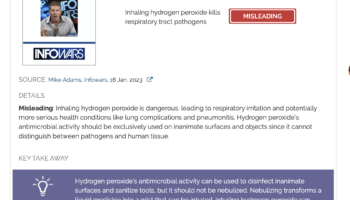- Health
Hydrogen peroxide given intravenously can be dangerous, has no known medical benefit
Key takeaway
Hydrogen peroxide is an effective disinfectant for inanimate objects and surfaces. However, using it internally by ingesting or injecting it can lead to serious health problems, depending on the strength of the hydrogen peroxide solution used. Swallowing a highly concentrated hydrogen peroxide solution can lead to burns that require emergency care and injecting hydrogen peroxide into the bloodstream generates air bubbles, which can lead to an air embolism.
Reviewed content

Verdict:
Claim:
Intravenous hydrogen peroxide "enables the body to cure itself of practically any disease"
Verdict detail
Incorrect: Public health guidance indicates that hydrogen peroxide shouldn’t be used internally, as this can be dangerous and there’s no known medical benefit to doing so. Injecting hydrogen peroxide generates air bubbles in the bloodstream, which can produce an air embolism, which is potentially fatal.
Full Claim
Intravenous hydrogen peroxide "enables the body to cure itself of practically any disease, without drugs, without surgery, chemotherapy or any other therapies by organized medicine"; it can fight infection and autoimmune disease
Review
A video uploaded to Facebook by astrologer and former radio talk show host Farley Malorrus, who has more than 16,000 followers, claimed that intravenous hydrogen peroxide “enables the body to cure itself of practically any disease, without drugs, without surgery, chemotherapy”. The video received more than 14,700 likes and more than 7,200 shares.
Hydrogen peroxide is a chemical that is commonly used as a disinfectant for inanimate objects, like contact lenses. It kills microorganisms by generating free radicals, and is active against various bacteria, fungi, and viruses. While hydrogen peroxide was commonly used to disinfect wounds in the past, this is no longer recommended as studies have found it irritates the skin and may do more harm than good.
Hydrogen peroxide is also used in dentists’ offices to whiten teeth[1] and is popular as a mouthwash. But Ada Cooper, a dentist and an American Dental Association spokesperson, told USA Today that those using it as a mouthwash should keep the concentration of hydrogen peroxide between 1.5 to 2%. Also, care should be taken not to hold the mouthwash in the mouth for too long, as the hydrogen peroxide can cause tissue damage.
Although it’s an effective disinfectant for inanimate objects, using it internally, such as by consuming it or injecting it into the bloodstream, is dangerous and there’s no known medical benefit for doing so. Because hydrogen peroxide quickly breaks down into water and oxygen, injecting it into the bloodstream generates air bubbles. This can lead to an air embolism, which can be fatal. For starters, the air bubbles can block blood circulation, leading to a stroke or heart attack.
During the COVID-19 pandemic, claims were rife about the purported effectiveness of spraying hydrogen peroxide in the mouth and nose to treat respiratory infections. Health Feedback explained in a previous review that this is unsafe, as it can cause respiratory irritation and inflammation, which would only serve to aggravate any existing respiratory ailment.
Poison Control explains that swallowing hydrogen peroxide can lead to various ill effects, depending on how concentrated the hydrogen peroxide solution is. Ingesting small amounts can cause a stomach upset but doesn’t otherwise result in long-lasting effects. However, large amounts or highly concentrated solutions can lead to burns that require emergency care.
Food-grade hydrogen peroxide, which contains 35% hydrogen peroxide, isn’t safe to consume despite its name. The name comes from its use in the food industry for purposes such as processing and bleaching certain foods. However, Poison Control noted that it has been promoted as a panacea for everything from HIV to irregular heart rhythm. This is in spite of the fact that claims of its medical benefits aren’t grounded in reliable scientific evidence and that there is no plausible biological mechanism that explains how hydrogen peroxide cures such illnesses.
Hydrogen peroxide has been tested in certain cancer studies, but these come with important caveats. There was a small study examining whether applying hydrogen peroxide to skin tumors could cause them to shrink and make the tumors simpler to remove surgically[2]. This didn’t involve injecting hydrogen peroxide nor was hydrogen peroxide used as a “cure”, since the tumors still required surgical removal.
There was a study in which hydrogen peroxide was injected into tumors to see if it enhanced the effect of radiotherapy[3]. In this case, hydrogen peroxide wasn’t injected into the bloodstream, which would be the case with intravenous administration. It was also used alongside radiotherapy, a proven cancer treatment—not on its own nor as the treatment itself.
Overall, while hydrogen peroxide is useful for disinfecting inanimate objects and can be used externally, such as for teeth whitening under a dentist’s supervision and as an occasional mouthwash, there’s no evidence that using hydrogen peroxide internally can treat “practically any disease” and plenty of evidence showing that injecting or ingesting it can cause serious harm.
REFERENCES
- 1 – Carey CM. (2014) Tooth Whitening. What We Now Know. Journal of Evidence-Based Dental Practice.
- 2 – Mundi et al. (2020) 33% hydrogen peroxide as a Neoadjuvant treatment in the surgical excision of non-melanoma skin cancers: a case series. Journal of Otolaryngology – Head & Neck Surgery.
- 3 – Nimalasena et al. (2020) Intratumoral Hydrogen Peroxide With Radiation Therapy in Locally Advanced Breast Cancer: Results From a Phase 1 Clinical Trial. International Journal of Radiation Oncology Biology Physics.



